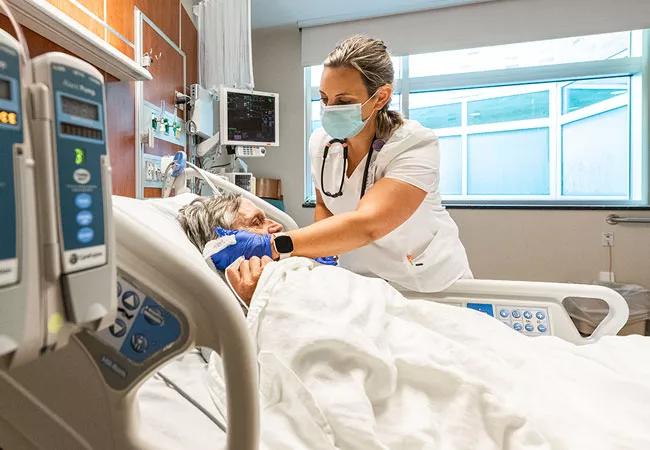Care team members collaborate to find the right place for every patient

As a nurse case manager in Cleveland Clinic’s emergency department, Lauren Delaney, RN, ACM, views the ED as unique place. “In a sense, it’s like the front door to the hospital,” Delaney says. Sometimes, those who arrive need emergency medical treatment and perhaps admission to the hospital. But other times, the ED is utilized as the door of last resort because a person needs a bit of medical attention and help finding other resources.
Advertisement
Cleveland Clinic is a non-profit academic medical center. Advertising on our site helps support our mission. We do not endorse non-Cleveland Clinic products or services. Policy
A Cleveland Clinic initiative introduced in 2017, driven by case management and developed by a multidisciplinary team under the direction of Stephen Meldon, MD, enables those patients to get the care that’s right for them and avoid a hospital stay.
“We have established a process that allows patients to be safely transitioned from the ED to their appropriate care setting,” Delaney says. “This might include a skilled nursing facility, hospice, a return home with homecare, and other alternatives.”
Case management in the ED fills a gap that at times had forced caregivers to choose between admitting patients who did not truly warrant hospitalization and releasing them to an environment where they might be at risk.
Finances and other social drivers of health are common issues among these patients.
“Let’s say a patient has diabetes and has had financial issues that have affected their ability to get medication,” Delaney says. “They may need to come in for a brief amount of time to receive medication or to speak to a diabetes educator. Now we are able to send them home with services put in place. We can help them follow up with endocrinology or a perhaps a primary care physician in the community.”
Conditions associated with aging also are frequently at play with avoidable hospital admissions from the ED.
“Some patients who are older seek most of their care in the emergency department because they don’t have access or transportation to a primary care provider, or because they need information on how to find one,” Delaney says. “If they are frequently bouncing around EDs, they tend to get fragmented care. These inconsistencies can lead to problems like polypharmacy, duplication of services and, ultimately, poor clinical outcomes.”
Advertisement
Now in Cleveland Clinic’s ED, Delaney and another case managers work with the care team to assess the needs of the patient at a holistic level and tap into resources that will help them after they leave.
Team members include any caregiver the patient might require depending on their needs.
“We work alongside the ED physicians, as well as physical therapists, occupational therapists, the pharmacy, geriatricians, and we all bring our own skills to the table,” Delaney says. “A patient who can be medically cleared may be released straight into a rehabilitation facility, for instance. We follow that patient until they have been released to the appropriate care, whether that’s at home or to a case management service in the community or with a plan for following up with a primary care physician. We are with them from assessment all the way to discharge.”
The case management program dovetails with Cleveland Clinic’s geriatric care unit, which allows for observation of patients with aging-related issues for up to 23 hours in the ED while being screened for polypharmacy, balance-related issues, cognitive impairment and other conditions.
“Sometimes after the person has been observed for a night, and perhaps received interventions, they look different than the person who you had thought might need to be admitted,” Delaney says. “With the proper follow-up care arranged, we have done them a great service by avoiding an unnecessary stay.”
That has been especially true during the pandemic, as hospitals have been eager to minimize the potential for exposure to COVID-19. Insurance providers, including Medicare, had already begun easing old restrictions that required patients be hospitalized for three nights, or receive preauthorization, before being released to a skilled nursing facility.
Advertisement
“Even before COVID, quite a few insurance providers had begun to allow us to discharge directly from the emergency room to the correct facility without an authorization process, and that has opened up even more,” Delaney says. “Beds are so very tight, and it just doesn’t make sense to expose the patient to a hospital stay if it’s not necessary.”
In cases involving older adults, the patient who comes into the ED with symptoms consistent with aging-related conditions now undergoes a full geriatric assessment. Case management may involve social workers and some financial assessment to determine agencies that can connect them with affordable further care. This could include qualifying for visits from home health aides or Meals on Wheels.
“In some cases, we have actually admitted people to long-term nursing homes directly from the emergency room because the patient has experienced a dramatic decline while living at home,” Delaney says.
Since the initiation of this ED-based, case management-driven program in 2017, avoiding unnecessary admissions has resulted in an approximate cost savings of over $450,000.
“As case managers, we are charged with the responsibility of managing resources appropriately by working alongside the team to provide the right care at the right time in the right place,” Delaney says. “This has become increasingly important during the pandemic, when our resources are severely limited. But as we do so, we always need to put our patients first.”
Advertisement
Advertisement

Nurses harness cutting-edge technology as a bridge to healing

Project aims to improve patient care by streamlining caregiver transitions

Optimizing care while protecting patients from life-threatening reactions

Palliative nurses improve quality of life

Strong bonds and momentous milestones fuel life-changing work

Experts offer hands-on support and education

Special skills course aims to improve patient safety and comfort while building caregiver confidence

Bariatric nurses deliver sensitivity, compassion and skill